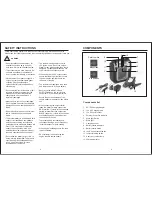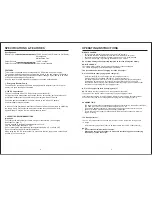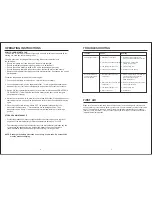
OPERATING INSTRUCTIONS
-6-
-7-
HOW TO JUMP START A CAR
The ENGINE STARTER provides a current up to 400 Amp (maximum) to assist with the
starting of a car when the car battery is flat.
Check to ensure the following before connecting the booster cable clamps to
the car battery:
• Ensure the ignition is off and the engine starter is fully charged.
• Ensure all ancillary equipment (lighting, radio etc.) is switched off.
• Ensure the vehicle battery is rated at 12V and is not damaged in any way.
• Ensure the battery terminals are perfectly clean; the clamps are firm and secure.
• Remove vehicle battery filler plugs and check electrolyte level. If necessary, top up with
distilled
water.
Follow the steps below to jump-start your car engine:
1. Connect the red clamp to the positive “+” terminal of the car battery.
2. Connect the black clamp to the negative terminal "-" or a well grouded chassis point
well away from any fuel lines or moving parts, and ensure the connection is secure.
3. Switch ‘ON’ the jumpstart safety switch (11) and leave in this condition FOR APPROX
FIVE MINUTES. (This will provide the vehicle battery with a short ‘boost’ charge to
allow for easier starting).
4. Switch the car ignition ‘ON’ to ‘start’ for no more than 6 seconds, if the engine does not
start within this time, switch off the ignition and wait for at least 3 minutes before trying
again.
5. Once the engine starts running, switch ‘OFF’ the jumpstart safety switch then
disconnect the black clamp “-” first and return it to its storage position. Then
disconnect the red clamp “+” from the battery terminal and restore it to its storage
position.
STORAGE & MAINTENANCE
• Protect the product from direct sunlight and other heat sources, as there is a risk of
explosion of the internal battery. Store at a temperature between 4ºC to 40ºC
• The technology used during the manufacture of the internal battery excludes any risk
of electrolyte gel leakage from the inside of the battery. You are nevertheless
recommended to keep the battery upright when storing it for long periods.
NOTE: Recharge the battery after each use or every 6 to 8 weeks. Do not exceed 2
months without charging.
TROUBLESHOOTING
FIRST AID
Trouble
Vehicle does not start
Device connected to
12V DC outlet socket
does not operate
Cause
1. Bad clamp connections
2. Very low vehicle battery charge
3. Low battery charge on unit
4. Vehicle battery defective
1. No output power at 12V DC
outlet
socket
2. Bad connection to the 12V DC
outlet
socket
3. Low battery charge on unit
4. Device fuse blown
Remedy
1. Rotate the clamps back & forth
to make a solid and better connection
2. Wait 3 to 4 minutes before
starting vehicle again
3. Fully recharge unit
4. Replace with new battery
1. Internal circuit breaker is off. Remove
accessory plug from unit socket.
Wait 15 minutes for unit to
automatically
reset
2. Re-insert accessory plug into 12V DC
outlet socket securely.
3. Fully recharge unit
4. Replace fuse
Make sure fresh water and soap are available nearby in case battery acid contacts skin,
eyes or clothing. If contact with battery acid occurs. rinse immediately and thoroughly with
water. Then wash with soap and water. Obtain immediate medical attention if redness,
irritation or pain is present. For eye contact flush eyes for at least 15 minutes and obtain
immediate medical attention.




